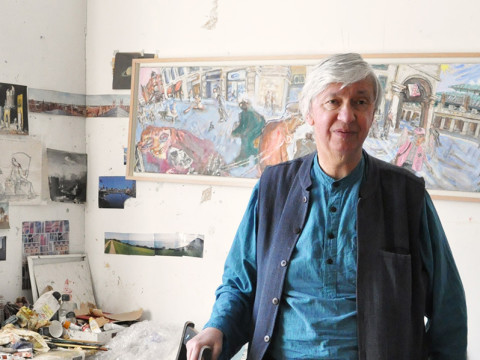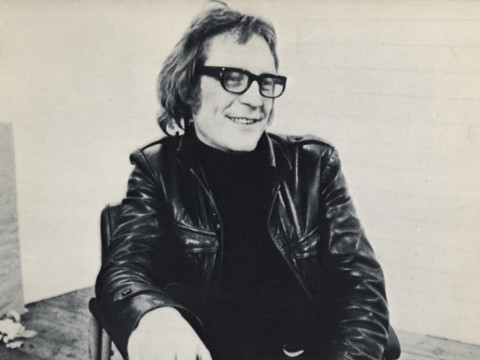
In memoriam: Sonia Lawson RA
By Nicholas Usherwood
Published on 11 September 2023
Nicholas Usherwood celebrates a progressive painter of great range and empathy.
From the Autumn 2023 issue of RA Magazine, issued quarterly to Friends of the RA.
Right from the start, with her election in 1982, Sonia Lawson’s relationship with the Royal Academy was always an extremely happy and quietly forceful one. At the 1984 Summer Exhibition, the room she curated, which was filled with large-scale figurative and abstract painting, elicited the comment from that ‘modernist’ critic of the day, Waldemar Januszczak, that she was “clearly a growing force” and that “the casual visitor might imagine he had walked into a celebration of progressive painting rather than the 216th Royal Academy Summer Show!” Soon after that, in 1985, she was made a Visiting Lecturer in the RA Schools, a role for which her quick wit and enormous empathy made her well suited. It always brought her the greatest pleasure too, right up to the point when, in 2003, a diagnosis of Parkinson’s Disease forced her to give up teaching.
Her election had come at a high point in her career, with the monumental canvases on political, social and humanistic themes that she had been making from the mid-1960s – works rich in those intensely human qualities of tenderness, empathy and pity – at last beginning to attract serious attention from curators. Even so, her work, though comparable in character to the great German and Italian painters of the period, such as Georg Baselitz and Mimmo Paladino, attracted little or no institutional attention. To this day she has no work in the Tate for example, attracting speculation that if she had perhaps been German or Italian – and a man – her name would almost certainly have been better known – and shown – than it has been.
For Sonia painting was a habit that she formed in childhood. Born in 1934, the only daughter of two highly regarded Yorkshire-based painters, Fred Lawson and Muriel Metcalfe, Sonia was plunged very young into the intellectual milieu of the Leeds Art Society of the late 1930s. Herbert Read and the great Jewish Expressionist painter, Jacob Kramer, visited the Lawsons’ Wensleydale cottage at Castle Bolton, as did other luminaries such as J.B. Priestley and William Roberts.

After training first at Worthing and Doncaster Art Schools, she arrived at the Royal College of Art in 1955, in its golden age, with Peter Blake, Frank Auerbach and Leon Kossoff two years ahead of her and David Hockney RA two years behind. Her mentor, later to become a lifelong friend, was the Professor, Carel Weight RA. Her painting underwent a series of stylistic transformations before crystallising in the 1960s with a group of excoriating canvases on themes of human brutality and political persecution – now largely forgotten, they still carry a huge power over half a century on.
“I am in painting like a fisherman is part of the sea,” Sonia once observed of herself, with paint always being the way in which she would land her ‘catch’, give pictorial form to the things she was thinking about and feeling. And reading too – from Kafka to John Clare, William Blake to the Brontë sisters, Sappho to Mary Wollstonecraft. For this, too, was a vital part of that shaping process, not just at a personal level but in a more conscious public way, coming out of her huge intellectual curiosity about the world. In those processes, lay the sparks that often set a new series of paintings in motion.
And behind all this again there was the Wensleydale of her childhood, the landscape that built itself into the fabric of her visual imagination. It was there always, at the heart of her painting. Right up almost to the last decade of her life she kept a house at West Witton, and visited it regularly from her Bedfordshire home where she and her husband Charlie Congo lived after their marriage in 1969.
In its early stages, Parkinson’s didn’t seem to halt the flow of her work, as the emphasis on landscape themes from the 1990s, often increasingly abstract in character, slowly transmuted into a miraculous late flowering. Astonishingly hued and densely textured, works like Night in a Private Garden (2010) fused figure and landscape in the most intensely elegiac of ways – a swansong, as it was to prove, to a career of rich achievement.
Nicholas Usherwood is a writer and curator, and author of Sonia Lawson: Passions and Alarms (Sansom & Co).
Related articles

In memoriam: Norman Ackroyd RA
20 September 2024

In memoriam: Timothy Hyman RA
12 September 2024

In memoriam: Mick Moon RA
1 May 2024

In memoriam: Joe Tilson RA
28 January 2024

In memoriam: Michael Hopkins RA
11 September 2023

In Memoriam: Antony Green RA
3 July 2023